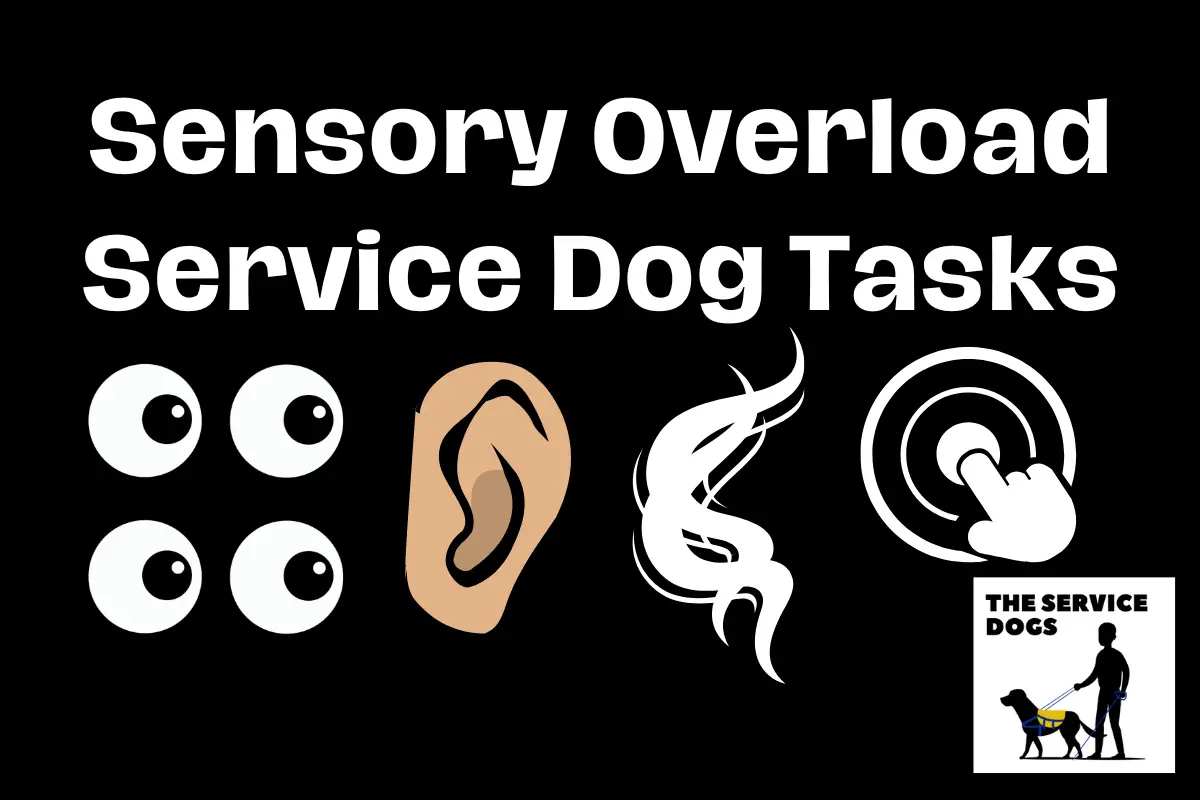Service Dog Tasks for Sensory Overload
What is sensory overload?
Sensory overload happens when a person is receiving a lot of input from the five senses – eyesight, hearing, taste, touch, and smell. How much? More than the brain can basically process, or sort through. Examples of when this can happen:
- Many conversations going on in the same room
- Loud sounds or music
- Flashing overhead lights
- Crowded spaces like shopping malls
- Emotionally intense environments
- Dramatic environmental changes in temperature or light
- Unwanted or sudden and unexpected physical contact
- Heavy traffic (loud sounds, sirens, etc.)
- Tactile triggers such as rough or uncomfortable clothing
- Strong smells

When people can not process
When certain people are unable to process the amount of stimulation they are experiencing, meltdowns can happen. They can be distressing. Read more about sensory overload on Healthline.
Sensory overload is sometimes associated with:
- Autism spectrum disorders
- Sensory processing disorder
- Post-traumatic stress disorder (PTSD)
- Fibromyalgia
How a service dog could help
When people become overstimulated, a trained service dog can help by serving as a calming and grounding point of contact.
They do so by:
- Deep pressure stimulation
- Kinetic engagement
- Tactile grounding
Sometimes, when an autistic person becomes overwhelmed, having a service dog nudge or paw at them can help the person to focus on just that one thing instead of a whole bunch of things.
Deep Pressure Stimulation
Deep Pressure Stimulation (DPS), Deep Pressure Therapy (DPT), and Deep Touch Pressure Therapy (DTP) are all names for the same thing. It’s basically a type of firm tactile contact, which means connected with the sense of touch.
Deep Pressure Therapy is used to calm and soothe the central nervous system in people who may be overstimulated. It can take different forms, including weighted blankets, swaddling, firm hugs, some type of compression, or, of course, the weight of a service dog.
Deep Pressure Therapy can help to reduce cortisol, blood pressure, stress, anxiety, and panic, and to increase serotonin and dopamine.
The dog can:
- Drape their entire body or just their torso across the lap of a person who is sitting
- Press against the person’s chest or legs
- Sit on a person’s feet
DPT can help to manage meltdowns and/or anxiety attacks, as well as can ground a person experiencing sensory overload. Read more about Deep Pressure Therapy service dogs on our blog.
Tactile Stimulation
Tactile stimulation means that a service dog is trained to touch the service dog handler. This can be either on command or automatically when the dog is trained to recognize particular symptoms or behaviors in the person.
The service dog may touch the person with their paw or their muzzle. This can be done once or repeatedly. Alternatively, the service dog may lick the person. This can be done either vigorously or gently. And it can be done either for a short time or until commanded to stop. It can be done on the person’s face, hands or somewhere else where it may be effective.
Licking the face also has the potential to engage the sense of smell in addition to the sense of touch. This can help to release cortisol and adrenaline. In turn, this can help a person engage, stay in the present moment, and act appropriately instead of shutting down or having another unwanted outcome.
Tactile stimulation also provides a focus point
When tactile stimulation is happening, the person can focus just on the touch from the service animal. This allows them to block out the remainder of the sensory input. Examples are too much noise, too much light, too much movement, or unpleasant temperatures.
Tactile stimulation can be grounding like deep pressure therapy and the two can actually work together. The result is calming and reconnecting the person to the current moment.
Related articles on our blog:
- What is a Psychiatric Service Dog?
- Psychiatric Service Dog Training – Tactile Stimulation + More
- Psychiatric Service Dog Tasks
- How to Train a Service Dog for Anxiety & Psych Tasks
Sam is an experienced writer, advocate for people with disabilities and mental health, dog lover, artist, philosopher, and generally complicated human being.
